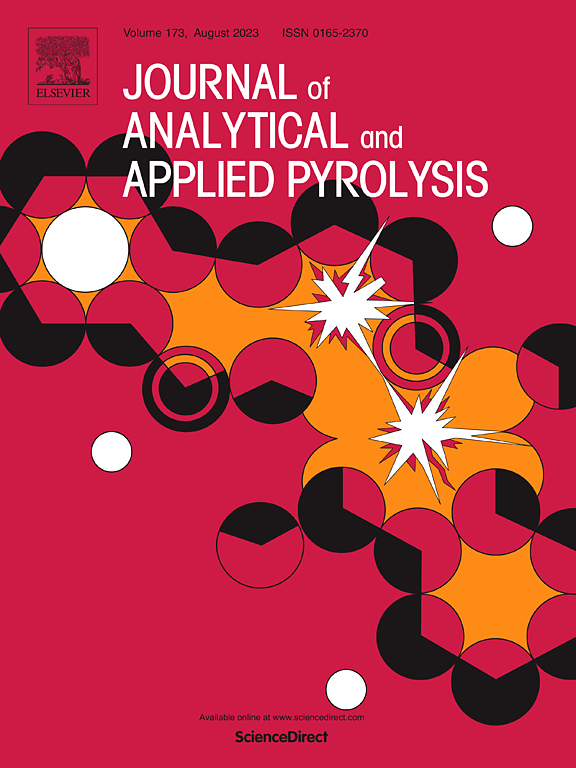大型生物质颗粒的热解:模型验证及其在咖啡壳增值中的应用
IF 5.8
2区 化学
Q1 CHEMISTRY, ANALYTICAL
引用次数: 0
摘要
在埃塞俄比亚,咖啡壳是一种宝贵的能源。热解热厚生物质颗粒在多个工业应用中发挥着至关重要的作用。尽管意义重大,但在这一过程中,与挥发性物质释放和残留生物炭形成相关的焓变往往被忽视。大颗粒热解的预测模型和新一代热解器的设计至关重要,尤其是在工业规模的应用中。因此,这项工作引入了一个全面的一维(1D)模型 BioSMOKE1D,以捕捉厚生物质颗粒热解的复杂性,并帮助设计优化的热解器。该模型集成了固相动力学机制、传输限制和二级气相焦油裂解反应。BioSMOKE1D 已通过全面验证,并通过复制各种大型生物质颗粒实验显示出令人印象深刻的预测准确性。该模型成功地再现了温度测量结果、质量损失曲线以及较低温度测量时的标示数据。然而,将气相机制和焦油二次裂解反应纳入模型后,在较高温度(650 ℃ 以上)下可获得更好的准确性。遗憾的是,据作者所知,目前还没有大颗粒咖啡壳热解的实验数据。因此,作者进行了多项参数分析,以确定模型参数对颗粒咖啡壳热解产率的影响。研究结果表明,生物质颗粒大小、温度和初始含水量会对转化时间、能耗、热解产物产量和物种分布产生重大影响。生物质颗粒尺寸越大,转化率越慢,能耗越高。这一建模工具有望优化咖啡壳作为可再生能源的利用,减少农业废弃物,促进经济增长。此外,这项研究的见解还为这些资源在工业规模应用中优化热解过程提供了宝贵的意见。本文章由计算机程序翻译,如有差异,请以英文原文为准。
Pyrolysis of large biomass particles: Model validation and application to coffee husks valorization
Coffee husk is a valuable source of energy in Ethiopia. Pyrolysis of thermally thick biomass particles plays a crucial role across several industrial applications. Despite its significance, the enthalpy changes associated with volatile species release and residual biochar formation during the process are often overlooked. Predictive models for the pyrolysis of large particles and designing a new generation of pyrolyzers are crucial, particularly for industrial-scale applications. Thus, this work introduces a comprehensive one-dimensional (1D) model, BioSMOKE1D, to capture the intricacies of pyrolysis in thick biomass particles and aid in designing optimized pyrolyzers. The model integrates a solid-phase kinetic mechanism, transport limitations, and secondary gas-phase tar-cracking reactions. The BioSMOKE1D has been thoroughly validated and exhibits impressive predictive accuracy by replicating various experiments on large biomass particles. The model successfully reproduces temperature measurements, mass loss profiles, and speciation data at lower temperature measurements. However, incorporating gas-phase mechanisms and secondary tar-cracking reactions has achieved better accuracy at higher temperatures (above 650 °C). Unfortunately, to the authors’ knowledge, no experimental data is available for the pyrolysis of large coffee husk particles. Therefore, several parametric analyses are performed to determine the effect of model parameters on the pyrolysis yields for pelletized coffee husks. The findings indicate that biomass particle size, temperature, and initial moisture content significantly affect conversion time, energy consumption, pyrolysis product yields, and species distributions. Larger biomass particle sizes correspond to slower conversion rates and increased energy consumption. This modeling tool holds promises for optimizing the utilization of coffee husks as a renewable energy source, mitigating agricultural waste, and boosting economic growth. Furthermore, the insights from this study provide valuable inputs for optimizing pyrolysis processes in industrial-scale applications of these resources.
求助全文
通过发布文献求助,成功后即可免费获取论文全文。
去求助
来源期刊
CiteScore
9.10
自引率
11.70%
发文量
340
审稿时长
44 days
期刊介绍:
The Journal of Analytical and Applied Pyrolysis (JAAP) is devoted to the publication of papers dealing with innovative applications of pyrolysis processes, the characterization of products related to pyrolysis reactions, and investigations of reaction mechanism. To be considered by JAAP, a manuscript should present significant progress in these topics. The novelty must be satisfactorily argued in the cover letter. A manuscript with a cover letter to the editor not addressing the novelty is likely to be rejected without review.

 求助内容:
求助内容: 应助结果提醒方式:
应助结果提醒方式:


